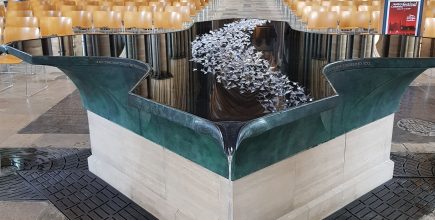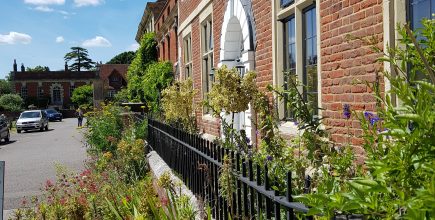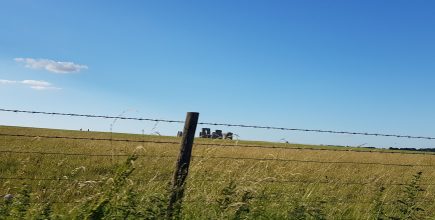01 A cathedral city calls its visitors back
When the UK went into lockdown, the people of Salisbury knew what they had to do. They had been there, just two years earlier, shut down by forces beyond their control. Unlike many of the rest of us, they know recovery is possible. They know how to fight back.
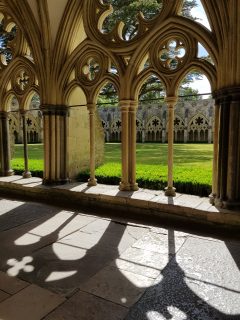
Salisbury Cathedral Cloisters
Sergei Skripal, a former Russian military officer and double agent for the UK’s intelligence services, and his daughter Yulia Skripal were poisoned in Salisbury on 4 March 2018.
Skripal and Yulia Skripal recovered, as did another victim, Detective Sergeant Nick Bailey.
The Prince of Wales and Duchess of Cornwall visited Salisbury on Friday, June 22. The royal couple spoke to shopkeepers and business people, and to local residents.
Their message was – Salisbury is open to business and there is nothing to fear.
The day before, June 21, when the skies were equally blue, and the gloom of the Skripal affair seemed to have lifted, I went to Salisbury to see for myself. There was, it seemed, nothing to fear, and much to admire in this resolute city’s fight back.
Alas, our optimism was short lived. Nine days later Charlie Rowley and his partner Dawn Sturgess fell dangerously ill at their home in nearby Amesbury.
It later transpired that Mr Rowley and Ms Sturgess had come into contact with A234, the same military-grade nerve agent that had been applied to Mr Skripal’s front door handle.
Ms Sturgess died in hospital on July 8, the one person to die in this dreadful episode. Mr Rowley was discharged from hospital the same day. Their families will have one small consolation, that they were sympathetically represented in the BBC dramatisation of the story, The Salisbury Poisonings (first shown on BBC 1, June 2020, in three one hour episodes).
It took a little longer, but the city of Salisbury itself is now fully recovered.
Salisbury – Nothing to see, but plenty to see. Don’t move on.
(I wrote this in 2018.)
What do you do when your city is hit by really seriously negative publicity? By some of the most damaging publicity it’s possible for an English cathedral city to suffer?
And what you do when you suffer yet another setback, just a few months into the recovery?
It’s simple. After the first attack you hung a cheery promotional banner around the restaurant the whole world knows Sergei Skripal and his daughter Yulia dined in in March (2018) after they’d been attacked with nerve agent, you picked yourself up and put yourself into what we used to call the “Spirit of the Blitz”. Then you carry on.
I found this Wiltshire community in full “there’s nothing to see, but don’t move on, come on in” mode just before novichok hit back and killed the unfortunate Dawn Sturgess. Her partner Charlie Rowley was also taken ill after being exposed to the nerve agent. But that’s still no more reason for tourists to stay away. Visitors are hardly likely to come searching for small receptacles, even if any have now escaped the meticulous sweep by the authorities, any more than the hundreds of people who come into the city centre to work every day would.
Everybody was especially cheerful in the glorious summer sunshine on my visit. They were welcoming and willing to help. The Prince of Wales was visiting next day. And the Skripals had been discharged from hospital.
Roly’s Fudge Pantry, one of the procession of independent shops on High St, summed up the mood of defiance. In the shop window there was a mockup of Stonehenge made from fudge, and refashioned as a football pitch. The score read “Novichok 0, Salisbury 1.”
The recovery is well underway. If you worry about the perils of everyday life, then don’t even leave home. There is no earthly reason not to visit Salisbury.
02 Things to see and do
The call of Constable
If you want to see the most powerful PR image promoting Salisbury’s recovery, proceed first to the Tate Gallery in London. “Salisbury Cathedral from the Meadows” is the artist Constable’s 1831 depiction of the great building. He sees it high and glorious under a stormy sky and a brilliant rainbow, from his easel across the River Avon.
Here was one of the city’s earliest, and most loyal, tourists. Constable often visited friends here. His work fixes Salisbury’s enduring reputation as one of the world’s leading foremost cathedral cities. We overuse the word shamefully, but this really is the city’s icon.
Cathedral Close - pure gold
To return to the real living Salisbury of today, its mother lode of pure touristic gold is the Cathedral Close, ringed by a clutch of distinguished old buildings. (It’s the largest such close in Britain. The National Trust offers a helpful online walk.)
Dominating everything is the cathedral itself, set in a vast carpet of green. On our visit it was hosting a touring exhibition of a flock of 2,500 white paper doves, suspended high above the Nave. We’ve been spotting the paper doves in shops and restaurants everywhere. The city had eagerly grasped this obvious symbol of peace as the theme of its recovery.
Magna Carta - city treasure
The cathedral holds the best of the surviving four parchment copies of Magna Carta, and it is on public display. UNESCO’s citation reads: ”76 lines of text, written in iron gall ink in Latin, in a neat business hand”. This flimsy, insubstantial document outlines nothing less than the mediaeval citizen’s rights, including the right to a fair trial.
Magnificent three
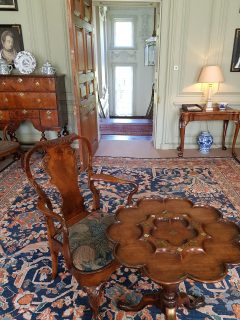 I would place Mompesson House, a resplendent film star of a Queen Anne house just across from the cathedral, on that shining string of National Trust properties at which you might want to break your journey on the way from London to the West Country. We were greeted by keen attendants in every room, extolling magnificent plasterwork and period furniture, the graceful oak staircase and a 400 piece collection of 18th-century drinking glasses.
I would place Mompesson House, a resplendent film star of a Queen Anne house just across from the cathedral, on that shining string of National Trust properties at which you might want to break your journey on the way from London to the West Country. We were greeted by keen attendants in every room, extolling magnificent plasterwork and period furniture, the graceful oak staircase and a 400 piece collection of 18th-century drinking glasses.
The next address is Arundells. I cannot imagine a more peaceful place to live as this, the former house of Prime Minister Edward Heath. On show here are his collection of paintings, photographs, sailing memorabilia and political cartoons. The Salisbury Museum completes a magnificent trio is. Most of the important archaeological finds relating to Stonehenge are on display.
St. Thomas’s Church - little gem
Back in the city centre, about a quarter of a mile away, venerable old Salisbury weaves in and out of 21st-century High Street commerce.
The unassuming St. Thomas’s Church is one of the most precious things here. It is easy to miss this ancient little gem. The story is that craftsmen that working on the cathedral in the 13th century would have come here to pray.
Venerable survivor
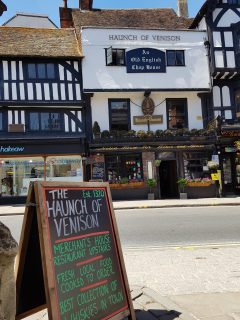 Another venerable survivor from old Salisbury is the nearby Haunch of Venison restaurant, built around 1320. Inside corridors and stairways ramble around like some absent-minded old deacon. Let the building lead you and you could end up in many an eccentric hidden nook or snug, including the one where it is thought Churchill and Eisenhower planned D-Day.
Another venerable survivor from old Salisbury is the nearby Haunch of Venison restaurant, built around 1320. Inside corridors and stairways ramble around like some absent-minded old deacon. Let the building lead you and you could end up in many an eccentric hidden nook or snug, including the one where it is thought Churchill and Eisenhower planned D-Day.
Stonehenge - "Great Rocks”
The city’s revival strategists have an ace to play. It is the gleaming green bus departing regularly from a stop in the Market Place. This is the Stonehenge Tour. A joint ticket covers the fare and entry to Stonehenge (about 10 miles away). The city used to promote with ultimate touristic understatement in its slogan: “Nice Church – Great Rocks”.
They opened an inconspicuous, well-designed interpretation centre at Stonehenge in 2013, to replace the untidy huddle of buildings that used to greet visitors. It has restored the dignity of the monument, and the sense of wonder. The circle is well out of view. Then, as you climb the hill outside the centre, either on foot or in a land train, those grey, gaunt stones, massive and mysterious, gradually come into view.
Old Sarum
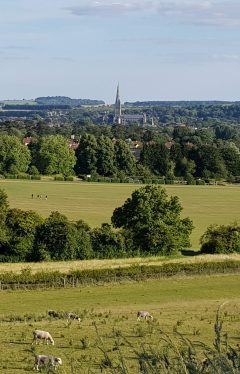 Salisbury tempted us to drive there that day with the promise of free park and ride. But there are excellent train services too. With the car – and it’s hard to make this visit without one – we called at Old Sarum, an ancient hill fort, and the original site of “old” Salisbury, two miles from the city centre. There is a tremendous view back towards the “new” Salisbury.
Salisbury tempted us to drive there that day with the promise of free park and ride. But there are excellent train services too. With the car – and it’s hard to make this visit without one – we called at Old Sarum, an ancient hill fort, and the original site of “old” Salisbury, two miles from the city centre. There is a tremendous view back towards the “new” Salisbury.
As we stood there, every bad association of the March 4th attack, the posturing, the power politics, the recriminations, evaporated. In front of us a simple, timeless tableau of meadows with grazing sheep, and, rising above a blur of buildings, a spirit of hope pointing to the deep blue sky. The cathedral.
03 A place to stay

